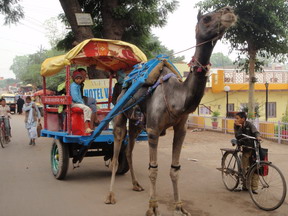Agra & Fatehpur Sikri Friday 6 – Friday 13 November 2009
We quickly were surrounded by a swarm of touts which didn't help matters as of course their commission is built into the fee. We were first taken to the Mayur hotel - a good central location but a bit dusty and we had to park outside. They wanted to charge 800 rupees which was extortionate. We shook off the touts and struck out on our own and soon found the Laurie Hotel - a bit out of town but with a great deal of space and apparently an old favourite with overlanders. They charge 150 rupees a head - a lot more acceptable! It was a strange set up apparently this is one of the oldest original Agra hotels and was once one of the grandest. This claim is backed up by the fact that the Queen and Prince Phillip actually stayed here in 1961 a fact recorded in pictures around the hotel. The manager proudly showed us the room the royal couple stayed in and our picture shows me sitting on the very bed her majesty once slept in.
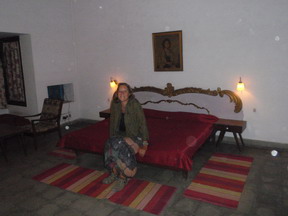

The Laurie was a strange hotel it was absolutely enormous with some grand old buildings but it was largely deserted, we only saw 2 other guests in all our time there! Apparently it is owned by a very wealthy man who won't spend any money on it. The rooms are very tired and definitely the place needs a facelift. We don't wish to complain though as it was perfect for us. We had a large grassy camping area totally to ourselves we were allowed to use their bathrooms (actually their showers were a bit erratic so we stuck to using our own but the thought was there!) and they let me use the room to sit and update my website so all in all it was a great camp spot and the staff were all very accommodating. Thankfully the temperatures are a lot lower and more comfortable at night than when we last passed through Agra at the height of the summer so great camping weather.
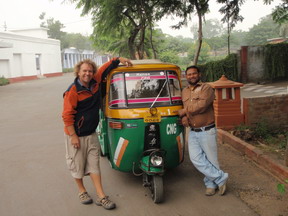

As we planned our next day's site seeing we decided to hire an auto rickshaw (or "Indian helicopter") for the day. As the attractions are spread out parking hard to find and the traffic unbelievably congested this meant it would be an easier day. Thus we hired Ali an auto rickshaw guy who works a lot for the Laurie and has had a lot to do with overlanders and he was a great help. He took us around all the sites and was altogether very kind and useful - we'd recommend him as a guide. Ali can be contacted via email gaffer_agra@yahoo.com or by mobile 0562 9720930252.
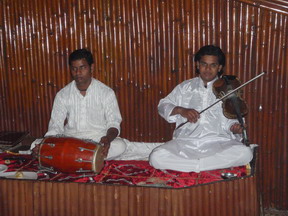
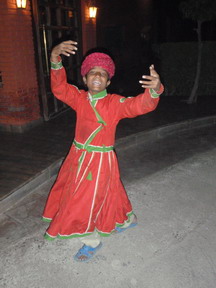
That night we were very tired and he took us to the nearby "Only Restaurant" for dinner. This was a lively set up - very touristy it was full of tour groups and had musicians playing local instruments and there was a little boy who met you at the door and performed local dancing. We don't usually do these super touristy things but it was enjoyable and the food was really nice so it made a change. After the last few days we were really tired so we went to bed really early.
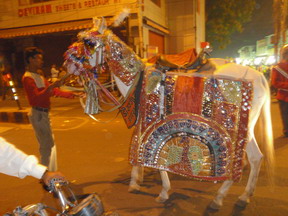
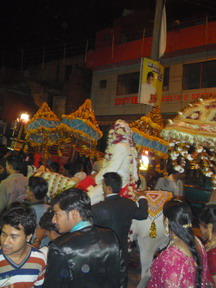
Unfortunately we were soon woken up. As mentioned before wedding season is very much upon us and you can't fail to notice the ornately lit up function halls and processions everywhere. We decided to get up and have a look as the procession went past us and it was a riot of colour. There was a band and followers dancing and the groom was on a beautifully decorated white horse all in all it was a real feast for the senses. Once it was past we were very relieved to collapse into bed once more - it was still only 9.30pm so we couldn't really complain!
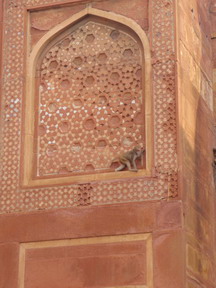
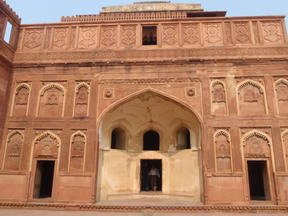
Initially built as a fortress by Emperor Akbar (the greatest Mughal ruler) in 1565 his grandson Shah Jahan -who went on to build the Taj Mahal - upgraded it to a palace and added a lot of detail in white marble which set against the original red sandstone looks truly stunning. The huge walls of the fort - 20 metres high and 2.5 metres thick - form an enclosure of a maze of buildings really a city within a city though sadly many of the buildings have since been destroyed.
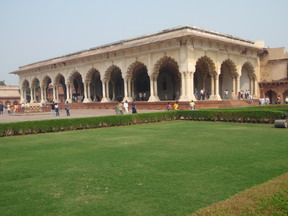
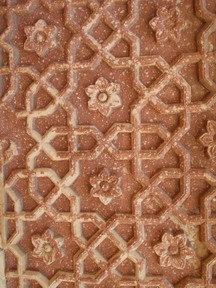
The building work and architecture was stunning - we wondered around gardens blown away by the exquisite craftsmanship. There was a large ornate gate on display - a war trophy of the British whose origins are unknown and which has somehow ended up at the fort though it has no real connection with it! The Brits claimed it was from Gujurat which was not true so the sign tells us it is a reminder of the lies the British East India Company told!

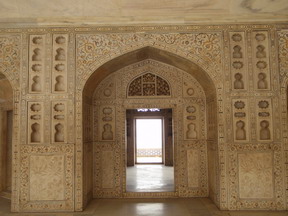
There were a few mosques within the complex and we particularly liked the Nagina Masjid or Gem Mosque which Shah Jahan built in 1653 to be used by the ladies of the court. It was in marble with extensive use of inlay work or pietra dura the Italian technique by which precious or semi precious stones are laid within the marble to give an elaborate pattern. This was a fore taste of the technique used on the Taj Mahal.
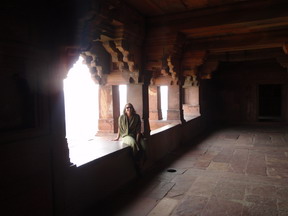

The fort was an impressive building. Like a lot of the Indian monuments we've seen everywhere there are monkeys and squirrels playing around the ruins which feels a nice touch somehow - like they're still being used!
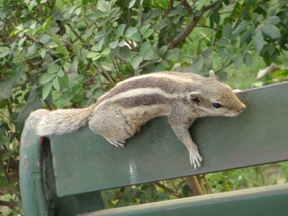
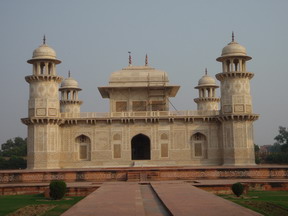
Next stop on the tour was the Itimad-ud-Daulah -AKA the Baby Taj. This was a really interesting building which we were lucky enough to enjoy more or less to ourselves. It was the tomb of a Persian nobleman Mizra Ghiyas Beg and his wife.

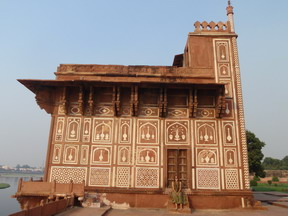
Built by their daughter between 1622 & 1628 and finished 3 years before the real Taj was commenced its design clearly foreshadowed the later building. It was the first Mughal building made totally from marble and the first to make use extensively of pietra dura over the walls. Whilst later we found it was not as jaw droppingly stunning as the Taj it was really lovely with an incredible attention to details and had a real tranquility which the Taj no longer has.


We then went to the nearby Chini-ka-Rauza which we'd never have found without Ali as it was down a maze of little side roads. This was a small riverside Persian style tomb built between 1628 and 1639 it housed the grave of Afzal Khan a poet and official in Shah Jahan's court. There were 2 tombs and according to the resident guide the other one housed the architect of the Taj Mahal - Shiraz someone you'd think they'd make more of this and I couldn't even confirm it as the guide book didn't mention it - so who knows.
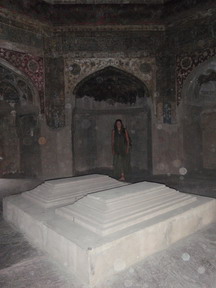
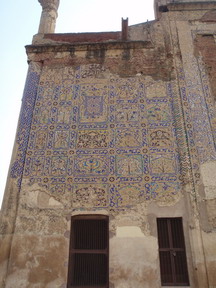
Anyway it was very understated a lovely setting down on the river. In Persian style this tomb had beautiful blue tiling though most of this had worn off. They were in the process of restoring it.
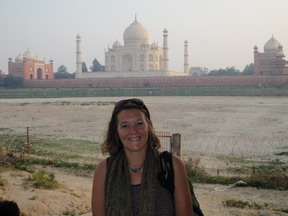
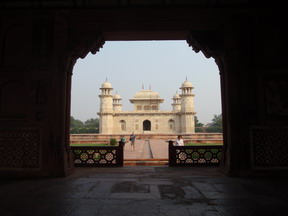
We then headed down the road to a spot directly across the river from the Taj which afforded a really good view for sunset photos. Actually there wasn't really much of a sunset- the weather was fine and sunny all day but the sky remained smoggy and overcast so no real sunset penetrated. Never mind it was still a great viewing of the famous monument.
We had a look at a beautifully landscaped garden directly opposite the Taj which had some footings. Unconfirmed but probable legend has it that Shah Jahan began here to build an exact mirror image of the Taj Mahal in black marble in which he was to be buried. The layout of these gardens - an exact copy of those at the Taj - and the size of the footings support this. His son put a stop to this by putting him in gaol so this was never completed. Shame! He also planned a connecting bridge between the 2 monuments. Would have been great for tourism if he'd pulled it off!
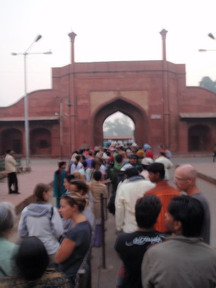

The next morning we'd arranged for Ali to come and pick us up to take us to the Taj Mahal at 5.30am to get there for the sunrise pictures. This was just aswell as it was still dark at this time and we were both sound asleep and would have slept on if he hadn't come and hammered on our car ! We got there to find a big queue already gathering. It costs 750 rupees for foreigners and only 20 rupees for Indians. This does seem a bit unfair but on the day we went (it was Sunday - in retrospect not the best day to pick!) the place was full of Indians who didn't look wealthy and school kids - it would be a real shame if they were priced out of seeing their own heritage - so we didn't really mind too much about the discrepancy.
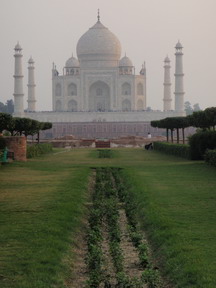
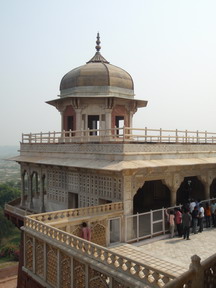
We quickly attracted a guide and decided to wear the cost as we really wanted to understand what we were seeing. We managed to bring the cost down by finding a really nice Dutch couple to split the costs with. Our guide Kashif was a 3rd generation Taj tourist guide and he certainly knew his stuff. We'd be happy to recommend his services and he can be contacted on 09558849390137.
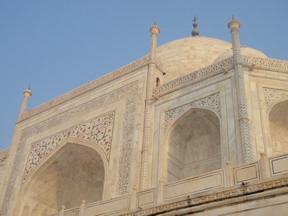

Work which commenced that year took 22 years to complete and involved 20,000 craftsmen from Indian and Asia and many more experts from all over the world with a number from Italy from where the pietra dura (marble inlay with semi- precious stones) technique originates.
The construction of the Taj cost around 3 million rupees - which would equate to around $70 million USD in today's money. Latterly there has been concern about pollution damaging the great monument and industry and polluting vehicles are now banned from the vicinity. Even so the smog hid much of the sunrise and we never saw the white marble change from gold to pink to blue as promised in the guide book!! Nevertheless the smog haze did create an ethereal other worldly quality to the Taj which was actually quite effective!
It is funny this icon is very much the image you see everywhere of India and we were concerned that after all the hype the reality would be a little disappointing. Not a bit of it. The Taj Mahal was the most incredible thing I've ever seen - that this level of perfection was achieved in the days before electricity and thus power tools was truly awe inspiring. Built in solid white marble the building and the gardens around it are totally symmetrical. Close up the marble is inlaid with verses from the Quran and amazing inlay work. Some of the intricate designs of flowers contain 96 separate pieces of stone painstakingly put together in a beautiful pattern. Words can't really describe it's something you have to see- truly mind blowing!
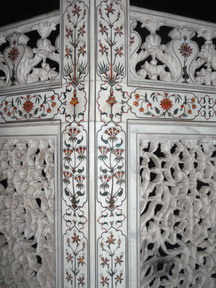

Cameras aren't allowed inside the actual tomb area where Mumtaz and her husband both lie. As mentioned earlier Shah Jahan didn't intend to end up here but was planning an identical black marble monument for himself. His usurping son buried him here with little ceremony in 1666 and the placement of his higher grave next to Mumtaz's is the only thing which stops the entire monument being perfectly symmetrical. The light is admitted into the tomb area by finely carved marble screens. In fact these graves are decoys the real graves are in a vault below and can only be viewed on 3 days a year and this wasn't one of them!
It was a very busy day when we were there and it was hard getting pictures without a crowd of people in the background. The famous "Princess Diana seat" where the famous pictures of that lady were taken is a popular picture venue and we did queue up to take our turn. Sadly we had a few and either there were a barrage of American tourists in the background or in the one good one I had my eyes shut!! The Princess didn't have these issues!
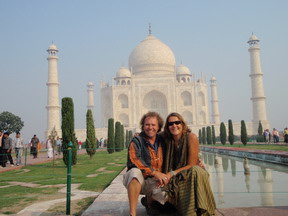
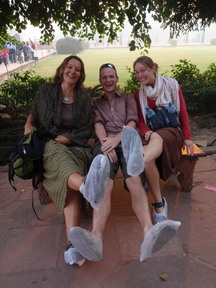
We wondered around taking it all in before leaving to once more brave the real world outside - touts flogging postcards and dusty noisy streets!

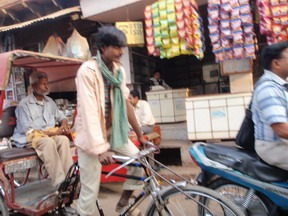
After this we headed out 10km to the northwest of town to see Akbar's Mausoleum a tribute to the greatest Mughal Emperor. Akbar - the grandfather of Shah Jahal of Taj Mahal fame is remembered for his tolerance of other religions- his policy was "Din-i-llahi" meaning Faith of God which preached the common truth of all religions and advocated tolerance. Thus it seemed fitting that a party of Buddhist monks had arrived just ahead of us!

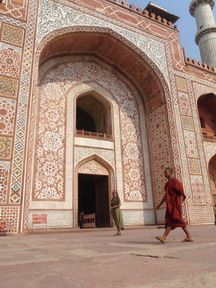
The tomb is set very beautifully - again away from the dirt and chaos of down town Agra - in a lovely park full of birds squirrels and herds of deer. The courtyard where the tomb lies is entered through a huge red sandstone gateway strikingly inlaid with white marble laid in geometric patterns.
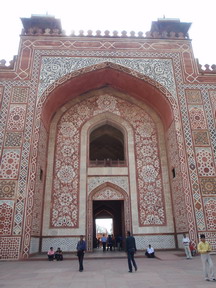
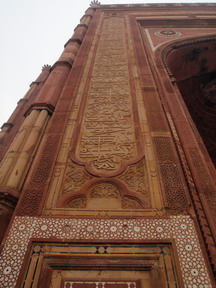
The actual tomb is within a vault full of painted designs in gold and blue and surrounded by Afghani (this is where Akbar came from) architecture. It was all very impressive.
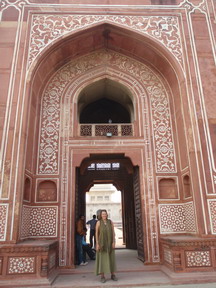
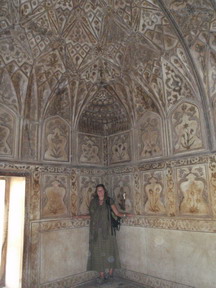
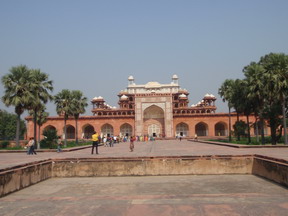

Agra being a big tourist centre you're never far away from shopping opportunities and we braved a marble factory. This was actually very interesting as as well as looking at the goods for sale we got to see how the technique is still performed today as it was in the days the Taj was built. The marble is painstakingly chipped out by hand the stones cut to shape and glued in with a nature glue. The stones are a wide variety e.g.) Jasper (brown) Lapislazuli (blue) coral (red) and Indian Jade (green) and are the same as those used in the Taj Mahal's construction. The price reflects the amount of work so often tiny articles with an amazing attention to detail are far more costly than much larger articles. Abdul Wahid at Zainub Export looked after us very well and Andrew got to watch the cricket on their TV.
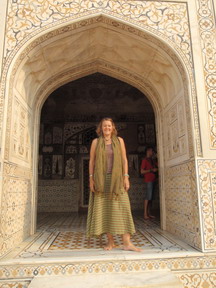
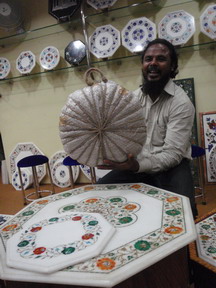
As an aside interest in Australia is huge after our cricket win and Ricky Ponting his achieved god like status here - thankfully this seems to have pushed the Melbourne attacks on Indians off the papers which is good! Abdul can be contacted by email or phone: zainubexport@yahoo.co.in 09358420672 or you can have a look at the products he sells on http://www.zainubexport.com He exports all over the world.

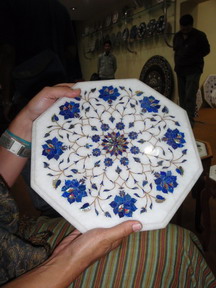
After all this sightseeing we had a couple of days taking it reasonably easy. Andrew got a few jobs done at street side shops (our shower tent is thankfully mended once more so we can again shower with confidence!) and I put in some hard yards in a hot internet shop! Our original website as it has so much information has been hard to load pictures onto but I have sweated on and finally got all the pictures for Kashmir on the last page of India. Whew! Have a look if you're interested. http://www.drivingoz2uk.com
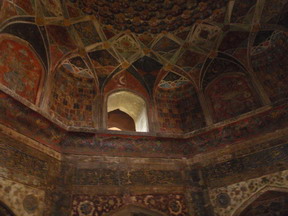
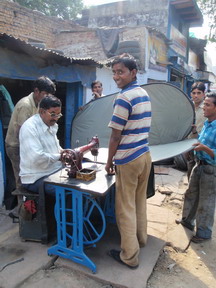
So on Wednesday 11 November - with my "homework" almost up to date we headed out to visit the nearby historical city of Fatehpuri Sikri (FS).
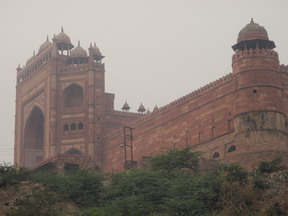
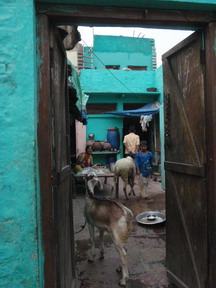
FS is a beautifully preserved ghost town built just 40km west of Agra. Akbar had 3 wives (one Hindu one Muslim one Christian - in keeping with his tolerance policy as above) but no heirs. In desperation he came to visit a holy man Shaikh Salim Christi who lived here. When this visit was rewarded by a male heir (named Salim after the holy man) he celebrated by building this city in his honour and shifting his capital here. Whilst a very beautiful city architecturally speaking it was a major failure as being far away from any rivers it suffered hugely from lack of water and was abandoned after Akbar's death in 1585 lasting only 14 years in total. Thus many of the buildings are still quite perfectly preserved making them very interesting for us to view.

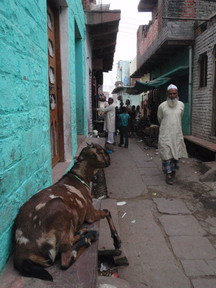
Arriving on the evening of Wednesday 11 November some touts on the town's edge tried to tell us we couldn't drive to the hotels and had to pay them to camp there, but we stuck to our guns and drove in to the Goverdhan Tourist Complex. Here the very friendly manager told us we could camp in his garden area for no charge and made us very welcome. Would that it was ever thus! This was a lovely peaceful spot near all the monuments and with a delicious vegetarian restaurant and we'd really recommend them as a place to stay. Have a look at their site http://www.hotelfatehpursikriviews.com

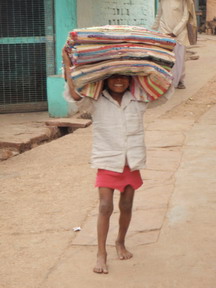
The bazaar area was very busy and full of life. We quickly found a guide in the form of a nice young guy who wanted to practice English so he tagged along with us. The local culinary specialty here is khataie a type of biscuit very like shortbread which you see piled high all around the bazaars and they were delicious. We made sure to buy the under cover ones as some of the ones in the open were swarming with flies!
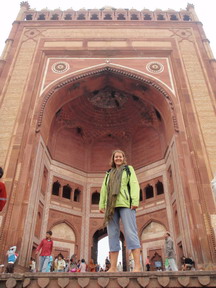
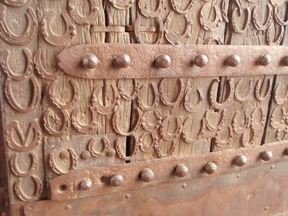
FS is divided into 2 distinct areas the mosque (Jama Masjid) area and its holy buildings and the palaces. We went first to have a look at the mosque as entry here was free. Completed in 1571 its design contains elements of both Hindu and Persian design eg) lotus flower carvings and the blue tiled archways. Entry is through the immense 54 metre Buland Darwaza or Victory Gate a really impressive structure said to have been built to celebrate Akbar's military victory over Gujarat. It is covered in horse shoes - like in our country these are supposed to be lucky. The quote from the Quran is from Jesus - also a Muslim prophet "The world is a bridge, pass over it but build no house upon it. He who hopes for an hour may hope for eternity." So there you go!


Inside is a huge courtyard, a red sandstone building containing the graves of the holy man's descendants - till this day they are buried here - and a separate white marble tomb where the holy man himself in buried. This is quite beautiful with many jalis or marble lattice screens all carved out of a single solid piece of white marble. These demonstrated amazing craftsmanship. You can go inside and file past the tomb which is surrounded by flower murals and under a beautiful mother of pearl canopy. As Akbar did all those years ago ladies come to pray for a son - throwing flowers on the grave and tying a thread to the jalis. This has been expanded to work for wishes about anything now - money issues, health success at work - and you just have to make a wish and it'll definitely be granted we were told. I had a go!
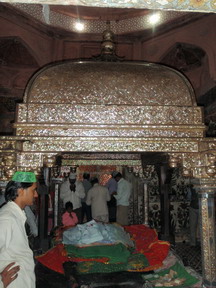
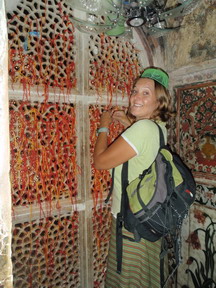
Around the courtyard were numerous merchants selling the area's specialty of carved marble work and various other artifacts. We were induced to have a look when suddenly a huge hue and cry went up and 2 kids came running hell for leather into the courtyard. Suddenly pandemonium broke out and everyone was throwing things into sacks to give to small kids who were away at the speed of light. The reason soon became clear as a load of police armed with batons appeared.
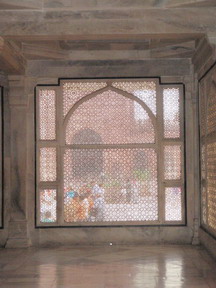
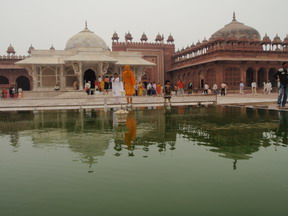

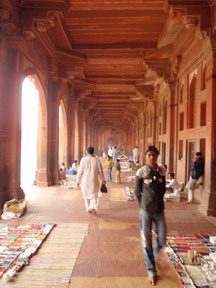
Apparently it is illegal to trade in this area though you really wouldn't know it. We imagine there is a system and probably the police are paid off but do the odd raid to look good. A couple of unlucky souls were caught and had their goods impounded but mainly it was as if it's never been the whole area was empty within 2 minutes!
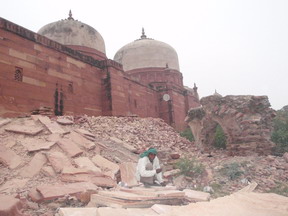

We had a walk around and saw some modern day stone masons in the shadow of the palace still working away in red sandstone. Andrew got involved in a game of cricket and again the kids were all very excited he was Australian. They all said Australia was their 2nd favourite team after India. When I mentioned England it flopped a bit "no madam that is not a good team at all." Oh dear!

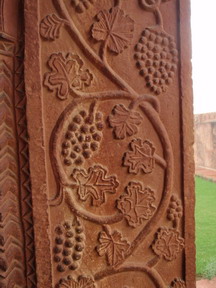
We then went back to take tea with our young guide which was an interesting look at how people live. Their home was deep in the Muslim quarter and the streets were a crazy jumble of houses, buffaloes and roof top goats. I managed to take a tumble down a stairway which shook me up a bit but I survived with just bruises!
 We went up onto the roof top from where we had a great view of the town. The local kids were very interested to see us and crowded around, they were all very friendly and made us welcome.
We went up onto the roof top from where we had a great view of the town. The local kids were very interested to see us and crowded around, they were all very friendly and made us welcome.
Our young host (sorry name forgotten!) was very nice and refused our offer of money for showing us around. He proudly told us he gets married in 6 weeks and invited us to come though sadly we won't be here. He is 14!!!!!
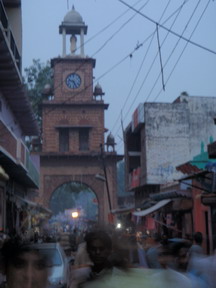
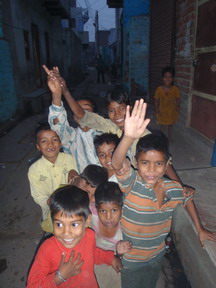
He seemed a nice sensible sort of kid but it seems so young. His brother of 26 who was also very nice already has 5 kids- like the poor everywhere this seems to be really trapping them. It's hard to comment though as it's such a different culture. We are frequently asked "do you have issues?" which is the wonderful India way of asking if you have kids. When we say not they are often opened mouthed with horror but the focus is not so much "how can you bear to live without children?" it's more "who will look after you when you're old?" The state - God help us!!!!
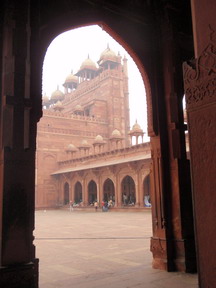
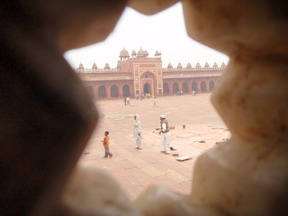
The next day we were up bright and early to see the rest of the buildings. The rain had come in from nowhere so it was on with the rain coats - we didn't mind though it was refreshing and kept some of the crowds at bay. As mentioned Akbar had 3 wives and it was the Hindu one Jodh Bai from Rajasthan who came up with the goods and produced the male heir. This was reflected a bit in the Queens' respective palaces hers was much bigger and grander than the other 2 and had a summer and winter section - we imagine this caused a fair bit of discord at the time!! It also had Hindu pillars like in their temples and Persian blue tiling.
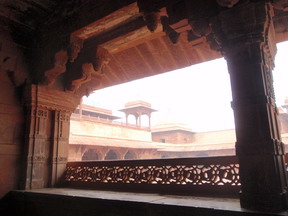
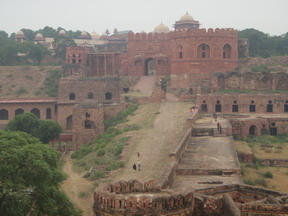
The Christian wife (Mariam from Goa) had a smaller palace with remainders of lovely paintings just visible and the Muslim wife (Sultana from Turkey) had a palace which whilst tiny was covered all over in gorgeous carvings mainly of grapes flowers and pomegranates. As I type I've just seen that my LP guidebook says Mariam the Christian wife was the one to produce the heir but our guide was adamant it was the Hindu Queen. Who knows we'll have to Google that one!

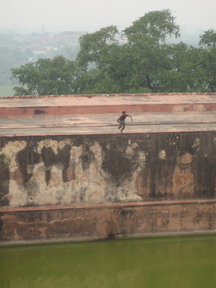
The various buildings were really interesting one - the Panch Mahal - a building to be used by the courts' ladies had 5 levels becoming progressively smaller. The lowest level had 84 pillars all of which were different.

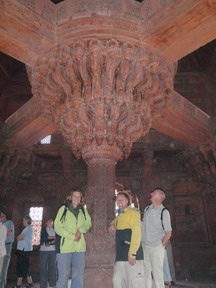
All in all the whole thing was very impressive. We went for a walk around the back and saw the Hiran Minar - or Hiran's tower built in honour of Akbar's favourite elephant. It was covered with stone elephant tusks making it look like a giant cactus. We climbed up inside but it was pitch black and very steep so it was a bit hairy and we quickly descended.
Finally we passed out of the Hathi Pol or elephant gate - though sadly the 2 elephants were a bit de-capitated! The whole place was fascinating.
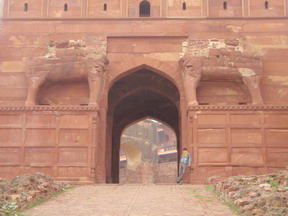
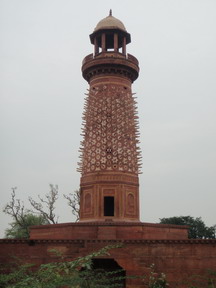
On the way back we decided to return by camel cart. Razoo was a lovely friendly camel and we liked to think we were supporting his welfare by having a ride. The young co-pilot who came along to translate - as the driver spoke no English- was funny. When I asked why he wasn't at school he informed me that he was far too old for school (he was 8) and that he "was working man." I asked what he did and he said he helped with the camels but that his main job was "tourist explaining." They grow up quickly in these parts!!

